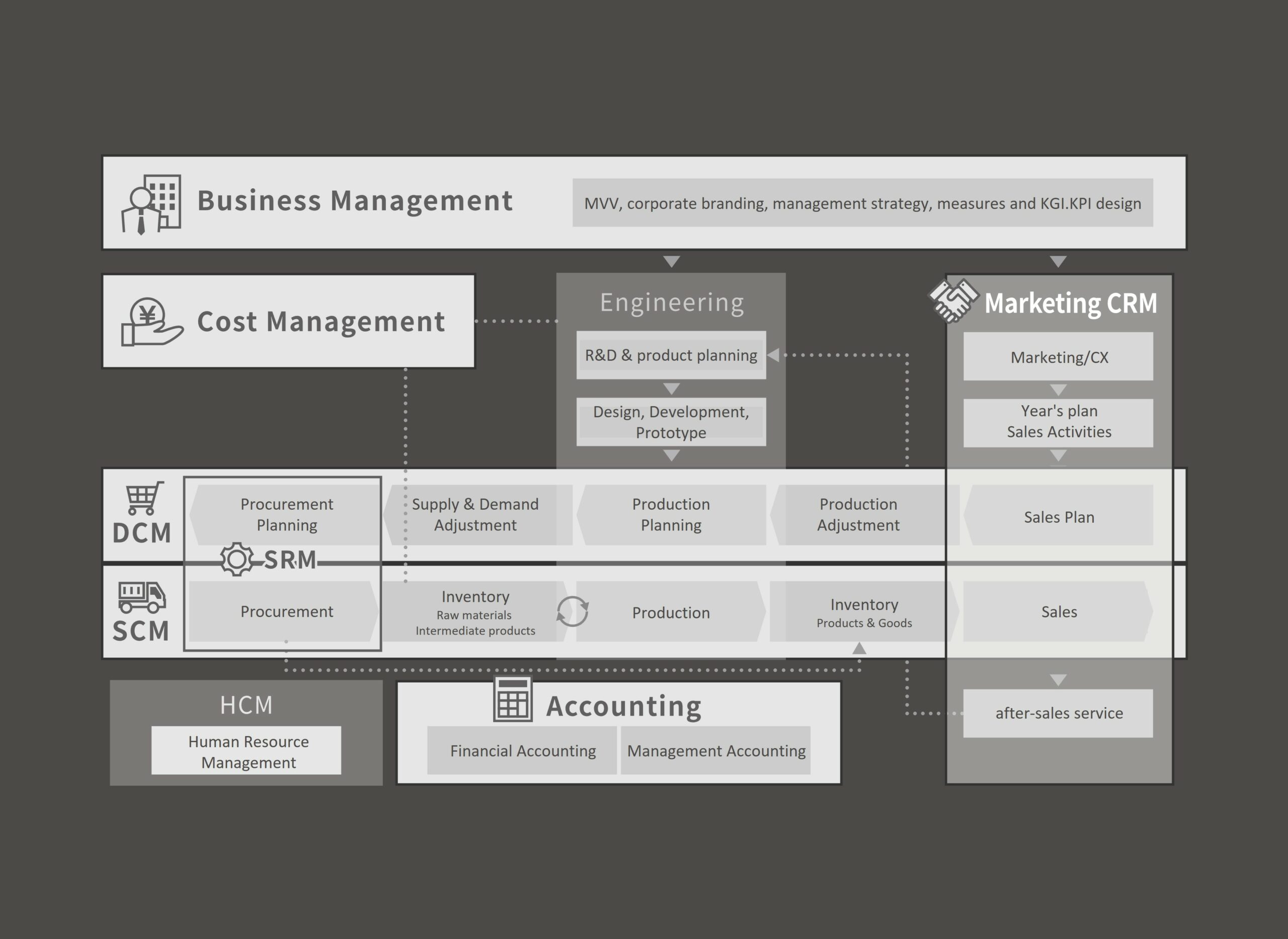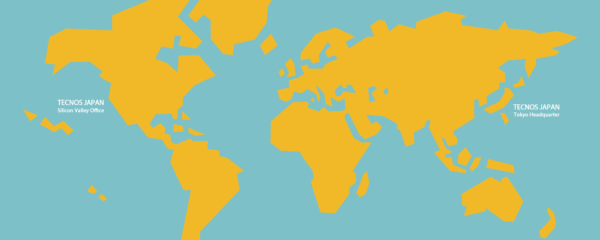Choose from Value Chain

Management and Business Domain/Value Chain

Business Management
- Mission, Vision and Values
- Corporate Branding
- Management strategy, measures, KGI / KPI design
Do you have any of these problems?
- We invested a lot of money to revamp our core system, but in the end it is just a box for data entry, with no information that we want to see as management.
- Data is in the system, but tabulation is done manually, so each person in charge spends a lot of man-hours to compile reports on a weekly/monthly basis.
- All reports that come out of management meetings are old result information from the past and are not used to make quick and effective management decisions.
Key Points of Business Management
Business management is not only the management of sales and profits, but also the management of all management information necessary for business decision-making, including the definition of the purpose and ideal state of corporate activities, such as corporate mission, vision, and values, corporate branding, management strategies and policies, and the management of the progress of corporate activities based on these. This can be defined as the management of all management information necessary for business decision-making, including the definition of the purpose and ideal state of corporate activities, corporate branding, management strategy and policies, and the management of the progress of corporate activities based on these. No matter how much money is spent on a system, if the management information necessary for decision-making cannot be grasped and managed at the necessary time, the value of a corporate system is merely a box for business processing, and we believe that it cannot be considered valuable.
Tecnos Japan considers this business management function to be the most important function of a corporate core system, and we focus on building corporate core systems based on data-oriented business management information design.
Marketing/CRM/SRM
Do you have any of these problems?
- Information is fragmented among marketing/sales/sales/support/purchasing departments, and information on each other’s activities is not sufficiently shared.
- Sales channels and Web (or EC) channels are fragmented, and the overall picture of customer purchasing behavior is not understood.
- Differences occur between sales order/sales information and accounting sales information, and it takes time to confirm and correct them.
Key Points of Marketing/CRM/SRM
Marketing is a concept that encompasses not only promotional activities such as advertising and promotion, but also the entire sales strategy. The importance of customer experience (CX) – who are the customers, what do they value, how do they think, and how do they act – is becoming more and more important in sales strategies these days. As a result of these sales strategies, sales activities are conducted, and the actual actions of customers as a result of these activities are traced and managed centrally in an effective funnel and fine mesh as company-wide CRM (Customer Relationship Management), without any disconnect between sales, sales, support, and other departments. SRM (Supplier Relationship Managemet) is likewise important for effective communication with suppliers. In the past, CRM/SRM was often managed separately and independently within the departments in direct contact with customers/suppliers, such as sales/support/purchasing departments, as an information system. However, since the actual value chain is connected to DCM/SCM systems such as sales/purchasing, it is becoming increasingly important to consider effective system integration.
Tecnos Japan can help customers optimize their customer contact activities by designing a system that effectively collects and stores increasingly complex and detailed CRM/CX information and links it to analysis, and by providing the skills and know-how to seamlessly link CRM information to ERP (Enterprise Resource Planning) from the perspective of the value chain. We support our clients in optimizing their customer contact activities.
DCM/SCM
Do you have any of these problems?
- Multiple EDI systems are in disarray within the company, making operation and management cumbersome, or order, logistics, and billing EDI are separated and inefficient.
- The system’s logical inventory and the actual inventory are different, or the logistics management function has been added to the inventory management function, and as a result, the system is no longer operational.
- Daily report management on the factory line is still done by hand on paper, or some of the line information has been acquired by IoT, but it is not effectively utilized.
Key points of DCM/SCM
Demand chain/supply chain management is a common corporate activity that exists in almost all companies. The demand chain is the flow of sales/production/purchase planning based on customer demand, and the supply chain is the flow of purchasing materials, producing products, and selling them accordingly. The following is an explanation of the key points in this process for each process.
Ordering Management
Although the ordering and receiving process is a common business activity for all companies, there are usually multiple suppliers for both purchasing and sales, and each supplier has multiple transaction methods and rules, which results in the complexity of the system itself. This is the reason for the complexity of the system itself. In order to improve efficiency, it is important to utilize a common infrastructure that bridges the gap between customers and suppliers.
Tecnos Japan provides a mechanism to manage order settlement information among multiple companies centrally on a cloud platform and seamlessly link it with ERP.
Inventory Management
As the volume and type of transactions grow to some extent, inventory management becomes more complex. Although systemization of inventory management is a basic function in a core system/ERP, eliminating the discrepancy between actual inventory and logical inventory in the actual warehouse can be quite difficult.
Tecnos Japan can help you to achieve the consistency of information and inventory optimization through a system that links the actual warehouse with the logical inventory.
Production Control
Along with the evolution of IoT, the visualization of information on factory lines is rapidly evolving. Various types of data that used to be recorded by humans in paper daily reports can now be automated by sensors, etc., allowing humans to shift to higher value-added operations.
Tecnos Japan can support the realization of smart factories by acquiring information from digital tools such as factory production information and daily production management reports and linking them with ERP.
Cost Management
- Cost Management
Do you have any of these problems?
- Cost management design continues to operate in a halfway state because it was not fully discussed at the time of the previous introduction.
- The current standard cost is not in line with the company’s experience, but it cannot be easily changed, so it is used as it is, or there is not enough time to conduct sufficient analysis of cost variances.
- Piloted digitization tools and IoT in a PoC, but then stopped without deployment.
Key Points of Cost Management
All companies in the manufacturing industry have some form of cost control. However, the level of cost control tends to vary from company to company, and in some cases, the rules and level of cost control often differ among group companies and divisions.
In addition, many companies set the standard cost by product at the beginning of the period and perform standard costing, but there are many companies that have not reviewed the standard cost itself for a long time. In order to quickly grasp the actual situation of manufacturing cost, which accounts for the largest part of profit and loss in most manufacturing industries, and to make decisions promptly, it is essential to acquire data efficiently without any difficulty and to design an operational flow.
Tecnos Japan can support the creation of a system that enables effective decision-making by combining data-oriented cost management item design, digitalization solutions, and various IoT, etc., connected to business management.
Accounting
- Financial Accounting
- Management Accounting
Do you have any of these problems?
- As a result of focusing on the financial accounting perspective, data with a granularity that can be used for management accounting is not being obtained.
- The previous project focused on process design and did not adequately identify the information required for management accounting.
- Despite having ERP in place, we are still busy with manual Excel data analysis on a weekly/monthly basis.
Key Points of Accounting/Cost Management
While accounting operations, especially financial accounting, must be performed by all companies, management accounting is an area in which the level of implementation varies widely from company to company. In particular, many companies that have implemented ERP have the top goal of improving the level of management accounting, and although there are high expectations for this goal, many companies may continue to use ERP without achieving the level they initially aimed for. This is often the case when the implementation process itself needs to be reviewed, which is often the case with projects that have been carried out with a process-oriented approach. However, management accounting requires a data-oriented approach in the upstream process.
Tecnos Japan can propose an overall design that integrates data and processes from the upstream process, based on an overall concept that places more emphasis on management accounting.




